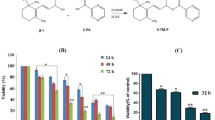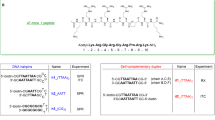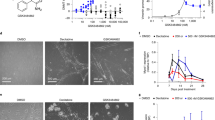Abstract
Ataxia telangiectasia (AT) is a human autosomal recessive disease that exhibits (in addition to the symptoms implied by its name) immune deficiencies, greatly increased risk of lymphoreticular cancer and unusual sensitivity to ionizing radiation (see ref. 1 for review). Although cells from AT patients are abnormally sensitive to killing by X-ray irradiation, DNA synthesis in AT cells is resistant to such treatment2,3. This resistance is primarily due to less inhibition of replicon initiation in AT cells than in normal cells, but there is also less inhibition of chain elongation in AT cells3. We now report that DNA synthesis in AT cells is also resistant to DNA damage induced by bleomycin but not to damage induced by N-methyl-N′-nitro-N-nitrosoguanidine (MNNG) or actinomycin D. Of these agents, only X rays and bleomycin directly cause DNA strand breaks, indicating that AT cells are defective in the system that in normal cells prolongs the time during which strand breaks can be repaired, replicon initiation inhibited and the chromatin structure returned to its normal state.
This is a preview of subscription content, access via your institution
Access options
Subscribe to this journal
Receive 51 print issues and online access
$199.00 per year
only $3.90 per issue
Buy this article
- Purchase on SpringerLink
- Instant access to full article PDF
Prices may be subject to local taxes which are calculated during checkout
Similar content being viewed by others
References
Paterson, M. C. & Smith, P. J. A. Rev. Genet. 13, 291–318 (1979).
Houldsworth, J. & Lavin, M. F. Nucleic Acids Res. 8, 3709–3720 (1980).
Painter, R. B. & Young, B. R. Proc. natn. Acad. Sci. U.S.A. 77, 7315–7317 (1980).
Watanabe, M., Takabe, Y., Katsumata, T., Terasima, T. & Umezawa, H. J. Antibiot., Tokyo 26, 417–423 (1973).
Makino, F. & Okada, S. Radiat. Res. 62, 37–51 (1975).
Walters, R. A. & Hildebrand, C. E. Biochem. biophys. Res. Commun. 65, 265–271 (1975).
Painter, R. B. & Young, B. R. Biochim. biophys. Acta 418, 146–153 (1976).
Watanabe, I. Radiat. Res. 58, 541–556 (1974).
Erickson, L. C., Ross, W. E. & Kohn, K. W. Chromosoma 74, 125–139 (1979).
Dahle, D., Griffiths, T. D. & Carpenter, J. G. Radiat. Res. 78, 542–549 (1979).
Taylor, A. M. R., Rosney, C. M. & Campbell, J. B. Cancer Res. 39, 1046–1050 (1979).
Povrik, L. F. & Painter, R. B. Biochim. biophys. Acta 432, 267–272 (1976).
Scudiero, D. A. Cancer Res. 40, 984–990 (1980).
Hoar, D. I. & Sargent, P. Nature 261, 590–592 (1976).
Suzuki, H., Nagai, K., Yamaki, H., Tanaka, N. & Umezawa, H. J. Antibiot., Tokyo 22, 446–448 (1969).
Zambetti-Bosseler, F. & Scott, D. Int. J. Radiat. Biol. (in the press).
Taylor, A. M. R., Metcalfe, J. A., Oxford, J. M. & Harnden, D. G. Nature 260, 441–443 (1976).
Saha, B. K. & Tolmach, L. J. Radiat. Res. 66, 76–89 (1976).
Author information
Authors and Affiliations
Rights and permissions
About this article
Cite this article
Cramer, P., Painter, R. Bleomycin-resistant DNA synthesis in ataxia telangiectasia cells. Nature 291, 671–672 (1981). https://doi.org/10.1038/291671a0
Received:
Accepted:
Issue date:
DOI: https://doi.org/10.1038/291671a0
This article is cited by
-
Gene expression in ataxia telangiectasia cells as perturbed by bleomycin treatment
Somatic Cell and Molecular Genetics (1992)
-
Ataxia-telangiectasia: an inherited disorder of ionizing-radiation sensitivity in man
Human Genetics (1987)
-
Study of chromatin structure in ataxia-telangiectasia cells
Molecular Biology Reports (1986)



